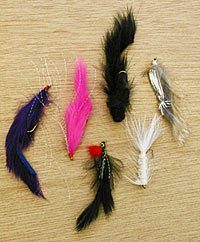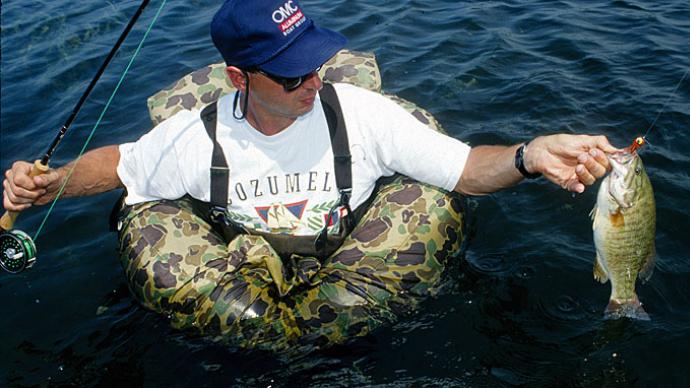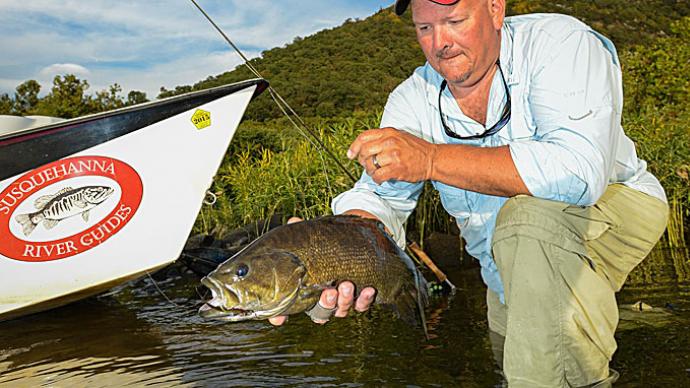
With summer winding down, water temperatures are falling, and bass are moving up and eating. This is the perfect time to try something new. How about catching bass on flies? If you have never caught a decent fish on a fly rod, you are in for a real treat – nothing beats the thrill of fighting a big fish or any fish on a fly rod.
You may not realize that even if you don’t own a fly rod, you can still fish flies for bass, and they work pretty well, often because the fish have never seen them before. Flies tend to be more subtle baits and work exceptionally well on small ponds and pressured waters. Fly fishermen tend to fish from tubes, but you can fish a fly from a bass boat.
However, a tube will let you get into little backwaters and the backs of coves where a big bass boat might not be able to fit. Often, a lake where trout are stocked will also have bass, which may be underfished. Most fly fishermen go after trout, and so do the bass. Bass on a trout diet gets big and fat.
What You Need
- 8 or 9-weight fly rod
- Forward weight floating line for poppers
- 200-grain sinking line for streamers
- Mono leader (16- to 20-pound test)
- Flies: big gurglers (topwater poppers), also an assortment of different sizes of streamers in patterns to match the fry, bluegills, shad, etc. Use smaller streamers when the fish are keying on fry and bigger ones when they are after shad.
Fly Rods

Traditionally, fly rods have always been nine feet long. This can make them a bit much to manage in a boat, but fly rod manufacturers are beginning to realize that bass fishing enthusiasts are a huge market. Many manufacturers make shorter, 8-foot fly rods specifically geared toward bass fishermen. If you are starting, see if you can borrow a fly rod or buy an inexpensive one until you fall in love with flyfishing. Many fly rods break down and can be stored and transported in small tubes, which makes them ideal for hiking into secret holes and backwaters.
When throwing a streamer, remember that a fly, unlike a crankbait or spinnerbait, has no built-in action. With no bill, a streamer dives, and with no wire, it thrums. It’s crucial to tie on with a loop knot to allow the fly as much movement as possible.
Largemouth bass prefer a faster retrieve in warmer water. For largemouth on streamers, try giving the line five or six short strips with a pause. The 200-grain sinking line falls at five inches per second so that you can count the flies down with a fair amount of precision.
If there are other large predator fish in the lake (like stripers, pike, etc.), the bass may not behave like they would if they were top dogs. Instead of pulling into deep channels in summer, they often pull out to slightly deeper brush and wait for the stripers or pike to herd the shad into the trees. In this case, you might find them in 15 feet of water or less, even when it’s still hot. Fish a fly over the brush they’re hiding in.
As soon as the water starts to cool off in the fall, bass move up into shallower water and get easier to catch. They move more, too, so you can pick up your topwater and reaction flies and start fishing the bank. There are plenty of great topwater flies for bass, including poppers. For poppers, strip just a little line simultaneously, pausing now and then. Popper flies are usually not as loud and don’t make as big a splash as, say, a Rico, but they get the job done. Many of them have little rubber legs that will wave around on the surface when you pause the lure, adding to the attraction.

A Cultiva Zip N Ziggy is a fantastic bait to use on a fly rod. Weighing in at 1/3-ounce, it has a curved belly that gives it a “walk the dog” motion when you pull a bit, stop, pull a bit, stop. The bass hammer these things, and they’re easy to fish even if you haven’t mastered walking the dog.
These topwater baits and poppers are so great you may want to try one even if you don’t have a fly rod. Some you can throw on light spinning gear. If you want to throw the lighter lures without a fly rod, you can use a floater bubble (also called a buldo) in front of the lure on a baitcaster or a spinning outfit. The weight of the bubble will make the lure castable, and you can fine-tune the weight by adding or releasing water from the bubble. Use a swivel and put the bubble above the leader and fly below, or use a bobber stopper, but don’t put anything above the bubble. It needs to float freely, so the fish doesn’t feel the weight when it takes the fly. Nine inches or so is ample for the leader. You can fish floating flies, light streamers, etc., on this rig. If the lure floats, you can make the leader longer if you want to, but the longer it is, the more difficult it is to cast.
First thing in the morning, try a topwater fly and throw it over long points at the entrances to caves and flats next to channel bends. Flats are deceptive -- a lot of guys pass right by a good flat because they tend to look like a “nothing” bank. But no flat is genuinely flat. Examine the bank – you’ll probably see little cuts and channels, and you can be sure they run right out into the lake. Those little dips in the bottom are just what the fish use to move up and down when they feed.
Even after you figure the fish out, you can’t just kick back and reel them in all day. If conditions change, you have to change too. Changes in light will make a difference. If clouds arrive or leave, the bite will change. Generally, the brighter and higher the sun, the tighter and deeper you have to fish. You need to be observant.
When the fish are locked on the structure, and you need to get down to them, a fly makes an incredible drop shot lure. Streamers made with long feathers and other light materials wave and shimmy in the water like no worm can—rig one on a light line on spinning gear with a cylinder weight. Leader length will depend on what you see on the graph. Or you can rig it so the weight stays on the bottom, and the streamer swims above the weeds. Where I live, we primarily fish rocks, so we use about an 18-inch leader to start. Cast to the bank and let the sinker reach the bottom. When the line goes slack, pick it up and move it just a bit, so the sinker falls further down the bank. The streamer will swim along behind and above, up off the bottom where the fish can see it. Usually, you’ll get bit while it’s sitting, and when you move the lure, it will feel heavy. Just reel set and get her in the boat. Other times the line will start to go sideways. If the fish are active, they may grab it and run, practically yanking the rod out of your hands.
You can drag this rig down points or channels. You can shake it gently beneath the boat when you spot fish on the graph. With today’s electronics, you can often see the lure and watch the fish come and take it. Since the fly is tied right onto the hook, these are longer lasting than a plastic worm and have more action. Because flies are so versatile, you can get any color you want, plus flash, eyes, or whatever. You may end up tying your someday. More than likely, a flyfishing club near you is a great place to start if you want to learn to tie your flies.
If you frequent a place like Sportsman’s Warehouse, wander to the fly section. You might be amazed at all the fantastic bass flies they have in stock. You can also buy bass flies online. For the ultimate thrill, fish them on a fly rod, but if you don’t want to invest in one of those right away, at least give them a try on your spinning gear or even a light baitcasting outfit. They flat-out catch fish.




